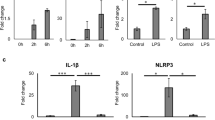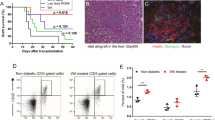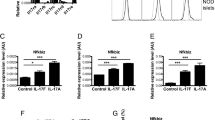Abstract
Although islet transplantation for individuals with type 1 diabetes has been shown to yield superior blood glucose control, it remains inadequate for long-term control. This is partly due to islet injuries and stresses that can lead to beta cell loss. Inhibition of excess IL-1β activity might minimize islet injuries, thus preserving function. The IL-1 receptor antagonist (IL-1Ra), an endogenous inhibitor of IL-1β, protects islets from cytokine-induced necrosis and apoptosis. Therefore, an imbalance between IL-1β and IL-1Ra might influence the courses of allogeneic and autoimmune responses to islets. Our group previously demonstrated that the circulating serine-protease inhibitor human alpha-1-antitrypsin (hAAT), the levels of which increase in circulation during acute-phase immune responses, exhibits anti-inflammatory and islet-protective properties, as well as immunomodulatory activity. In the present study, we sought to determine whether the pancreatic islet allograft-protective activity of hAAT was mediated by IL-1Ra induction. Our results demonstrated that hAAT led to a 2.04-fold increase in IL-1Ra expression in stimulated macrophages and that hAAT-pre-treated islet grafts exhibited a 4.851-fold increase in IL-1Ra transcript levels, which were associated with a moderate inflammatory profile. Unexpectedly, islets that were isolated from IL-1Ra-knockout mice and pre-treated with hAAT before grafting into wild-type mice yielded an increase in intragraft IL-1Ra expression that was presumably derived from infiltrating host cells, albeit in the absence of hAAT treatment of the host. Indeed, hAAT-pre-treated islets generated hAAT-free conditioned medium that could induce IL-1Ra production in cultured macrophages. Finally, we demonstrated that hAAT promoted a distinct phosphorylation and nuclear translocation pattern for p65, a key transcription factor required for IL-1Ra expression.
This is a preview of subscription content, access via your institution
Access options
Subscribe to this journal
Receive 12 digital issues and online access to articles
$119.00 per year
only $9.92 per issue
Buy this article
- Purchase on Springer Link
- Instant access to full article PDF
Prices may be subject to local taxes which are calculated during checkout






Similar content being viewed by others
References
Eizirik DL, Mandrup-Poulsen T . A choice of death—the signal-transduction of immune-mediated beta-cell apoptosis. Diabetologia 2001; 44: 2115–2133.
van der Windt DJ, Bottino R, Casu A, Campanile N, Cooper DK . Rapid loss of intraportally transplanted islets: an overview of pathophysiology and preventive strategies. Xenotransplantation 2007; 14: 288–297.
Mandrup-Poulsen T, Bendtzen K, Nerup J, Dinarello CA, Svenson M, Nielsen JH . Affinity-purified human interleukin I is cytotoxic to isolated islets of Langerhans. Diabetologia 1986; 29: 63–67.
van Belle TL, Coppieters KT, von Herrath MG . Type 1 diabetes: etiology, immunology, and therapeutic strategies. Physiol Rev 2011; 91: 79–118.
Filippi CM, von Herrath MG . Islet beta-cell death—fuel to sustain autoimmunity? Immunity 2007; 27: 183–185.
Yamada K, Takane-Gyotoku N, Yuan X, Ichikawa F, Inada C, Nonaka K . Mouse islet cell lysis mediated by interleukin-1-induced Fas. Diabetologia 1996; 39: 1306–1312.
Suarez-Pinzon WL, Power RF, Rabinovitch A . Fas ligand-mediated mechanisms are involved in autoimmune destruction of islet beta cells in non-obese diabetic mice. Diabetologia 2000; 43: 1149–1156.
Ylipaasto P, Smura T, Gopalacharyulu P, Paananen A, Seppanen-Laakso T, Kaijalainen S et al. Enterovirus-induced gene expression profile is critical for human pancreatic islet destruction. Diabetologia 2012; 55: 3273–3283.
Ramesh A, Chhabra P, Brayman KL . Pancreatic islet transplantation in type 1 diabetes mellitus: an update on recent developments. Curr Diabetes Rev 2013; 9: 294–311.
Barshes NR, Wyllie S, Goss JA . Inflammation-mediated dysfunction and apoptosis in pancreatic islet transplantation: implications for intrahepatic grafts. J Leukoc Biol 2005; 77: 587–597.
Schwarznau A, Hanson MS, Sperger JM, Schram BR, Danobeitia JS, Greenwood KK et al. IL-1beta receptor blockade protects islets against pro-inflammatory cytokine induced necrosis and apoptosis. J Cell Physiol 2009; 220: 341–347.
Barshes NR, Wyllie S, Goss JA . Inflammation-mediated dysfunction and apoptosis in pancreatic islet transplantation: implications for intrahepatic grafts. J Leukoc Biol 2005; 77: 587–597.
Dinarello CA . Interleukin-1 in the pathogenesis and treatment of inflammatory diseases. Blood 2011; 117: 3720–3732.
Arend WP . The balance between IL-1 and IL-1Ra in disease. Cytokine Growth Factor Rev 2002; 13: 323–340.
Akash MS, Rehman K, Sun H, Chen S . Sustained delivery of IL-1Ra from PF127-gel reduces hyperglycemia in diabetic GK-rats. PloS ONE 2013; 8: e55925.
Schwarznau A, Hanson MS, Sperger JM, Schram BR, Danobeitia JS, Greenwood KK et al. IL-1beta receptor blockade protects islets against pro-inflammatory cytokine induced necrosis and apoptosis. J Cell Physiol 2009; 220: 341–347.
Larsen CM, Faulenbach M, Vaag A, Ehses JA, Donath MY, Mandrup-Poulsen T . Sustained effects of interleukin-1 receptor antagonist treatment in type 2 diabetes. Diabetes Care 2009; 32: 1663–1668.
Larsen CM, Faulenbach M, Vaag A, Volund A, Ehses JA, Seifert B et al. Interleukin-1-receptor antagonist in type 2 diabetes mellitus. N Engl J Med 2007; 356: 1517–1526.
Arend WP, Malyak M, Guthridge CJ, Gabay C . Interleukin-1 receptor antagonist: role in biology. Annu Rev Immunol 1998; 16: 27–55.
Glas R, Sauter NS, Schulthess FT, Shu L, Oberholzer J, Maedler K . Purinergic P2X7 receptors regulate secretion of interleukin-1 receptor antagonist and beta cell function and survival. Diabetologia 2009; 52: 1579–1588.
Maedler K, Sergeev P, Ehses JA, Mathe Z, Bosco D, Berney T et al. Leptin modulates beta cell expression of IL-1 receptor antagonist and release of IL-1beta in human islets. Proc Natl Acad Sci USA 2004; 101: 8138–8143.
Smith MF, Jr ., Eidlen D, Brewer MT, Eisenberg SP, Arend WP, Gutierrez-Hartmann A. Human IL-1 receptor antagonist promoter. Cell type-specific activity and identification of regulatory regions. J Immunol 1992; 149: 2000–2007.
Andersson J, Bjork L, Dinarello CA, Towbin H, Andersson U . Lipopolysaccharide induces human interleukin-1 receptor antagonist and interleukin-1 production in the same cell. Eur J Immunol 1992; 22: 2617–2623.
Jenkins JK, Arend WP . Interleukin 1 receptor antagonist production in human monocytes is induced by IL-1 alpha, IL-3, IL-4 and GM-CSF. Cytokine 1993; 5: 407–415.
Luhm J, Langenkamp U, Hensel J, Frohn C, Brand JM, Hennig H et al. Beta-(1→3)-D-glucan modulates DNA binding of nuclear factors kappaB, AT and IL-6 leading to an anti-inflammatory shift of the IL-1beta/IL-1 receptor antagonist ratio. BMC Immunol 2006; 7: 5.
Ishida Y, Kondo T, Kimura A, Matsushima K, Mukaida N . Absence of IL-1 receptor antagonist impaired wound healing along with aberrant NF-kappaB activation and a reciprocal suppression of TGF-beta signal pathway. J Immunol 2006; 176: 5598–5606.
Smith MF Jr, Eidlen D, Arend WP, Gutierrez-Hartmann A . LPS-induced expression of the human IL-1 receptor antagonist gene is controlled by multiple interacting promoter elements. J Immunol 1994; 153: 3584–3593.
Lewis EC . Expanding the clinical indications for alpha1-antitrypsin therapy. Mol Med 2012; 18: 957–970.
Russi EW . Alpha-1 antitrypsin: now available, but do we need it? Swiss Med Wkly 2008; 138: 191–196.
Toso C, Serre-Beinier V, Emamaullee J, Merani S, Armanet M, Wojtusciszyn A et al. The role of macrophage migration inhibitory factor in mouse islet transplantation. Transplantation 2008; 86: 1361–1369.
Pott GB, Chan ED, Dinarello CA, Shapiro L . Alpha-1-antitrypsin is an endogenous inhibitor of proinflammatory cytokine production in whole blood. J Leukoc Biol 2009; 85: 886–895.
Ozeri E, Mizrahi M, Shahaf G, Lewis EC . alpha-1 antitrypsin promotes semimature, IL-10-producing and readily migrating tolerogenic dendritic cells. J Immunol 2012; 189: 146–153.
Tawara I, Sun Y, Lewis EC, Toubai T, Evers R, Nieves E et al. Alpha-1-antitrypsin monotherapy reduces graft-versus-host disease after experimental allogeneic bone marrow transplantation. Proc Natl Acad Sci USA 2012; 109: 564–569.
Shahaf G, Moser H, Ozeri E, Mizrahi M, Abecassis A, Lewis EC . alpha-1-antitrypsin gene delivery reduces inflammation, increases T-regulatory cell population size and prevents islet allograft rejection. Mol Med 2011; 17: 1000–1011.
Subramanian S, Shahaf G, Ozeri E, Miller LM, Vandenbark AA, Lewis EC et al. Sustained expression of circulating human alpha-1 antitrypsin reduces inflammation, increases CD4+FoxP3+ Treg cell population and prevents signs of experimental autoimmune encephalomyelitis in mice. Metab Brain Dis 2011; 26: 107–113.
Toldo S, Seropian IM, Mezzaroma E, Van Tassell BW, Salloum FN, Lewis EC et al. Alpha-1 antitrypsin inhibits caspase-1 and protects from acute myocardial ischemia-reperfusion injury. J Mol Cell Cardiol 2011; 51: 244–251.
Wang Y, He Y, Abraham B, Rouhani FN, Brantly ML, Scott DE et al. Cytosolic, autocrine alpha-1 proteinase inhibitor (A1PI) inhibits caspase-1 and blocks IL-1beta dependent cytokine release in monocytes. PloS ONE 2012; 7: e51078.
Stoller JK, Aboussouan LS . A review of alpha1-antitrypsin deficiency. Am J Respir Crit Care Med 2012; 185: 246–259.
Kalis M, Kumar R, Janciauskiene S, Salehi A, Cilio CM . alpha 1-antitrypsin enhances insulin secretion and prevents cytokine-mediated apoptosis in pancreatic beta-cells. Islets 2010; 2: 185–189.
Zhang B, Lu Y, Campbell-Thompson M, Spencer T, Wasserfall C, Atkinson M et al. Alpha1-antitrypsin protects beta-cells from apoptosis. Diabetes 2007; 56: 1316–1323.
Zhou X, Shapiro L, Fellingham G, Willardson BM, Burton GF . HIV replication in CD4+ T lymphocytes in the presence and absence of follicular dendritic cells: inhibition of replication mediated by alpha-1-antitrypsin through altered IkappaBalpha ubiquitination. J Immunol 2011; 186: 3148–3155.
Chan ED, Pott GB, Silkoff PE, Ralston AH, Bryan CL, Shapiro L . Alpha-1-antitrypsin inhibits nitric oxide production. J Leukoc Biol 2012; 92: 1251–1260.
Churg A, Dai J, Zay K, Karsan A, Hendricks R, Yee C et al. Alpha-1-antitrypsin and a broad spectrum metalloprotease inhibitor, RS113456, have similar acute anti-inflammatory effects. Lab Invest 2001; 81: 1119–1131.
Tilg H, Vannier E, Vachino G, Dinarello CA, Mier JW . Antiinflammatory properties of hepatic acute phase proteins: preferential induction of interleukin 1 (IL-1) receptor antagonist over IL-1 beta synthesis by human peripheral blood mononuclear cells. J Exp Med 1993; 178: 1629–1636.
Lewis EC, Mizrahi M, Toledano M, Defelice N, Wright JL, Churg A et al. alpha1-Antitrypsin monotherapy induces immune tolerance during islet allograft transplantation in mice. Proc Natl Acad Sci USA 2008; 105: 16236–16241.
Mendez J, Stillman B . Chromatin association of human origin recognition complex, cdc6, and minichromosome maintenance proteins during the cell cycle: assembly of prereplication complexes in late mitosis. Mol Cell Biol 2000; 20: 8602–8612.
Pott GB, Chan ED, Dinarello CA, Shapiro L . Alpha-1-antitrypsin is an endogenous inhibitor of proinflammatory cytokine production in whole blood. J Leukoc Biol 2009; 85: 886–895.
Tawara I, Sun Y, Lewis EC, Toubai T, Evers R, Nieves E et al. Alpha-1-antitrypsin monotherapy reduces graft-versus-host disease after experimental allogeneic bone marrow transplantation. Proc Natl Acad Sci USA 2012; 109: 564–569.
Kline JN, Fisher PA, Monick MM, Hunninghake GW . Regulation of interleukin-1 receptor antagonist by Th1 and Th2 cytokines. Am J Physiol 1995; 269: L92–L98.
Marie C, Pitton C, Fitting C, Cavaillon JM . IL-10 and IL-4 synergize with TNF-alpha to induce IL-1ra production by human neutrophils. Cytokine 1996; 8: 147–151.
Jenkins JK, Malyak M, Arend WP . The effects of interleukin-10 on interleukin-1 receptor antagonist and interleukin-1 beta production in human monocytes and neutrophils. Lymphokine Cytokine Res 1994; 13: 47–54.
Cassatella MA, Meda L, Gasperini S, Calzetti F, Bonora S . Interleukin 10 (IL-10) upregulates IL-1 receptor antagonist production from lipopolysaccharide-stimulated human polymorphonuclear leukocytes by delaying mRNA degradation. J Exp Med 1994; 179: 1695–1699.
Tamassia N, Castellucci M, Rossato M, Gasperini S, Bosisio D, Giacomelli M et al. Uncovering an IL-10-dependent NF-kappaB recruitment to the IL-1ra promoter that is impaired in STAT3 functionally defective patients. FASEB J 2010; 24: 1365–1375.
Subramanian S, Shahaf G, Ozeri E, Miller LM, Vandenbark AA, Lewis EC et al. Sustained expression of circulating human alpha-1 antitrypsin reduces inflammation, increases CD4+FoxP3+ Treg cell population and prevents signs of experimental autoimmune encephalomyelitis in mice. Metab Brain Dis 2011; 26: 107–113.
Ozeri E, Mizrahi M, Shahaf G, Lewis EC . Alpha-1 antitrypsin promotes semi-mature, interleukin-10-producing and readily migrating tolerogenic dendritic cells. J Immunol 2012; 189: 146–153.
Koulmanda M, Bhasin M, Hoffman L, Fan Z, Qipo A, Shi H et al. Curative and beta cell regenerative effects of alpha1-antitrypsin treatment in autoimmune diabetic NOD mice. Proc Natl Acad Sci USA 2008; 105: 16242–16247.
Goldstein S, Reddy P . Tolerance without toxicity? alpha1-antitrypsin as a novel alternative to immunosuppression. Expert Rev Clin Immunol 2012; 8: 397–399.
Thoms HC, Loveridge CJ, Simpson J, Clipson A, Reinhardt K, Dunlop MG et al. Nucleolar targeting of RelAp65 is regulated by COMMD1-dependent ubiquitination. Cancer Res 2010; 70: 139–149.
Makowiec F, Koveker G, Weber P, Jenss H, Starlinger M . Crohn's disease: disease activity and recurrence following surgery. Deut Med Wochenschr 1990; 115: 1659–1664. German.
Hochrainer K, Racchumi G, Zhang S, Iadecola C, Anrather J . Monoubiquitination of nuclear RelA negatively regulates NF-kappaB activity independent of proteasomal degradation. Cell Mol Life Sci 2012; 69: 2057–2073.
Nita IM, Serapinas D, Janciauskiene SM . alpha1-Antitrypsin regulates CD14 expression and soluble CD14 levels in human monocytes in vitro. Int J Biochem Cell Biol 2007; 39: 1165–1176.
Author information
Authors and Affiliations
Corresponding author
Rights and permissions
About this article
Cite this article
Abecassis, A., Schuster, R., Shahaf, G. et al. α1-antitrypsin increases interleukin-1 receptor antagonist production during pancreatic islet graft transplantation. Cell Mol Immunol 11, 377–386 (2014). https://doi.org/10.1038/cmi.2014.17
Received:
Revised:
Accepted:
Published:
Issue Date:
DOI: https://doi.org/10.1038/cmi.2014.17
Keywords
This article is cited by
-
Bile and urine peptide marker profiles: access keys to molecular pathways and biological processes in cholangiocarcinoma
Journal of Biomedical Science (2020)
-
Review 2: Primary graft dysfunction after lung transplant—pathophysiology, clinical considerations and therapeutic targets
Journal of Anesthesia (2020)
-
Immune protective effect of human alpha-1-antitrypsin gene during β cell transplantation in diabetic mice
Immunologic Research (2015)



